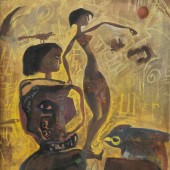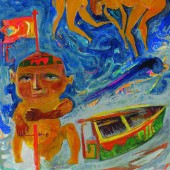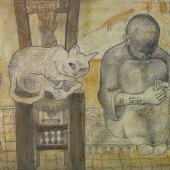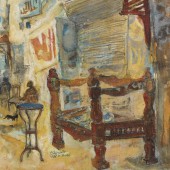Hamed Nada
- Country: Egypt
- Exhibitions:
- A Century in Flux
- Beloved Bodies
- Sky Over The East
As one of the most prominent painters of Egypt’s modern period, Hamed Nada touched on symbolism, superstition, daily life and the world of the djinn through stylised figuration. Nada was influenced by his religious upbringing and experience of living in the Sayyida Zeinab district of Cairo. While working as an illustrator for the seminal Egyptian writer Taha Hussein, Nada attended Cairo’s School of Fine Arts. A student of the renowned painter and teacher Hussein Youssef Amin, who rejected the school's traditional curriculum, Nada joined other Egyptian artists including Abdel Hadi el-Gazzar, Samir Rafi and Kamal Youssef to form the Group of Contemporary Art. In the 1950s, Nada began to focus on the daily plight of the Egyptian working class, later moving towards more political subjects in his work. In 1960, Nada studied mural painting at the Royal Academy of Fine Arts of San Fernando in Madrid and became head of the painting department at Cairo University in 1977.
بوصفه أحد أبرز الرسامين في فترة الحداثة في مصر، تناول حامد ندا الرمزية والأساطير والحياة اليومية وعالم الجن من خلال التشخيص الاختزالي. تأثر ندا بتربيته الدينية ونشأته في حي السيدة زينب في القاهرة. والتحق بمدرسة الفنون الجميلة في القاهرة أثناء عمله كرسام لدى الكاتب المصري البارز طه حسين. كما كان طالباً لدى الرسام الشهير والمعلم حسين يوسف أمين، الذي رفض المنهج التقليدي في التدريس، وانضم إلى فنانين مصريين آخرين من ضمنهم عبد الهادي الجزار وسمير رافع وكمال يوسف لتشكيل جماعة الفن المعاصر. بدأ ندا في الخمسينيات بالتركيز على المعاناة اليومية للطبقة العاملة المصرية، وتحول لاحقاً إلى مواضيع أكثر سياسية في أعماله. ودرس عام 1960 رسم الجداريات في الأكاديمية الملكية للفنون الجميلة في سان فرناندو بمدريد، ثم أصبح رئيساً لقسم الرسم في جامعة القاهرة عام 1977.
Related artists by country
- Ahmed Askalany
- Adam Henein
- Chant Avedissian
- Fathi Afifi
- Fathi Hassan
- George Bahgory
- Ghada Amer
- Huda Lutfi
- Khaled Hafez
- Lara Baladi
- Abdel Hadi El Gazzar
- Ahmed Moustafa
- Raafat Ishak
- Susan Hefuna
- Youssef Nabil
- Gazbia Sirry
- Ragheb Ayad
- Seif Wanly
- Samir Rafi
- Omar El Nagdi
- Kamel Moustafa
- Kareem Lotfy
- Mahmoud Said
- Mohammed Naghi
- Nermine Hammam
- Youssef Kamel
- Hazem Mahdy
- Ayad Al Nimar
- Mohammed Ismail
- Adel El Siwi
- Adham Wanly
- Guirguis Lotfy
- Hussein Bicar
- Inji Efflatoun
- Kamel El Telmesani
- Khaled Zaki
- Moataz Nasr
- Reda Abdelrahman
- Shaaban Zaki
- Effat Naghi
- Farghali Abdel Hafiz
- Mohammed Sabry
- Wael Darwish
- Mohammed Abla
- Ahmed Kassem
- Marwa Adel
- Ammar Abo Bakr
- Basim Magdy
- Ganzeer
- Iman Issa
- Mohamed Abou El Naga
- Clea Badaro
- Farida El Gazzar
- Hamed Ewais
- Maha Maamoun
- Marguerite Nakhla
- Ramses Younan
- Salah Abdel Kerim
- Yasser Rostom
- Amr Nazeer
- Aya Tarek
- George Hanna Sabbagh
- Nadim Raef
- Tahia Halim
- Hussein Fawzi
- Ahmed Morsi
- Walid Ebeid
- Ezequiel Baroukh
- Saad El Khadem
- Van Leo
- Mamdouh Ammar
- Salah Taher
- Zeinab Abd El Hamid
- Armen Agop
- Wassef Boutros-Ghali
- Menhat Helmy
- Mariam Abdel-Aleem
- Hamed Abdalla
- Alaa Awad
- Ehsan Mokthar
- Fatma Arargi
- Salam Yousry
- Anna Boghighuian
- Gamal El Sagini
- Leila Izzat
- Mahmoud Afifi
- Nadia Mohammed
- Rebab Nemr
- Khadiga Riad
- Abdel Badie Abdel Hay







